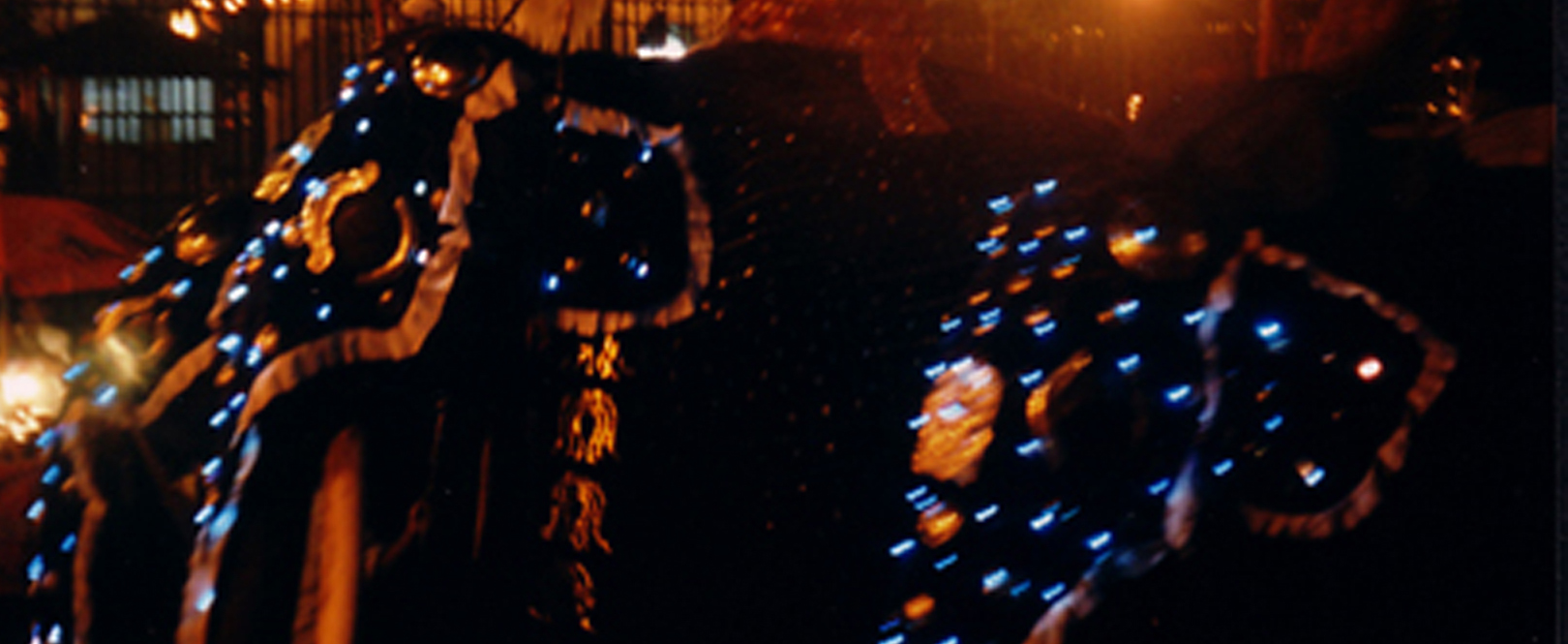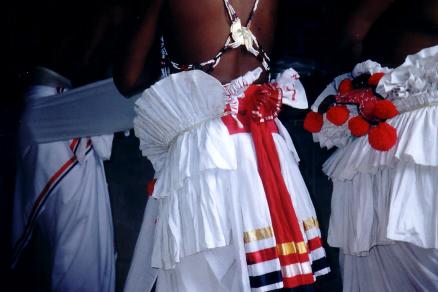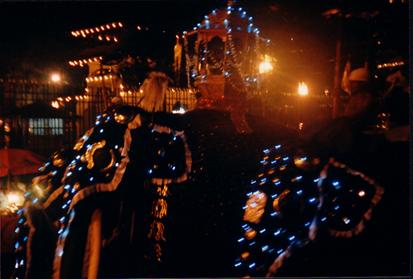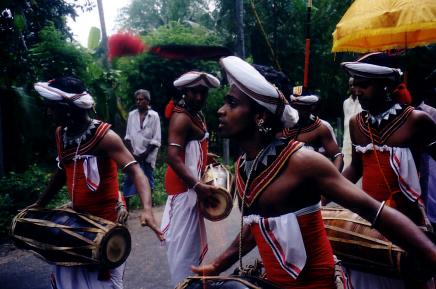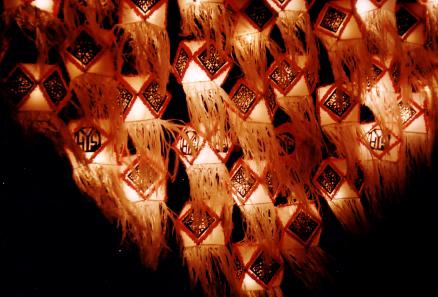Asia Link Residency, Tim Newth - Sri Lanka
Text
Sri Lanka
May 6-July 26, 2002
Tim Newth was based with Vishawapadma Sansadaya (the Universal Lotus Society) in Peradeniya just outside Kandy.
"I was to participate in three major cultural events; Vesak - Buddha’s birthday and lantern festival, Poson - Full Moon ceremony (of which the Universal Lotus Society was to conduct its major project for the year) and the Kandy Tooth Relic Temple’s Annual procession. I was to give presentations to arts students, indigenous groups and dance groups.
I was interested to see if the residency reinforced the following state of observation. “As an artist based in Darwin, there are strong influences from Indigenous Australia and South East Asia where work is often created in a much more communal way and events created for the ‘wet’ or the ‘dry’ seasons. Here the interconnectedness of art and its relationship to people, place and spirit is vital. In developing contemporary work that is relevant to people it is necessary to work with people within their own contexts and to understand the practice as it exists in its original environment.”
Diary Extracts
Vesak
Vesak was celebrated only two and half weeks following my arrival. This is the major event in the country and people right across the island make lanterns from many different materials in all shapes and sizes. Families make lanterns for outside their houses and shop owners commission artists to create lanterns for outside their shops. There are lantern competitions in Kandy but especially in Colombo. Groups get together to make huge community lanterns, some the size of a merry-go-round with their own motors so they rotate. They have soundtracks playing and highly elaborate lighting systems. They are often made in great secrecy, building temporary walls around the work sites until completed. I had imagined these lanterns to be lit by candles but they are powered by electricity. It seems everyone is capable of being an electrician and wire into the nearest power outlet. I became involved with three different lantern-making groups and it is here that I first met with Sumudu, Nilantha and Wasantha.
“Vesak is coming to a close, some of my most enjoyable times have been spent making lanterns with a group of young men. Each night we would work later and later making our giant set of bright pink lotus lanterns, until the last night we were up till well after 3am. We laughed alot as we tried to teach each other our different languages. A group of us did a walk around the Kandy Lake on Vesak night where there were so many people and amazing lanterns. The lights shining from everywhere looked so beautiful across the lake. Such a great positive energy.
I have just returned from Colombo (the capital of Sri Lanka) where we saw the lantern competitions. They were incredible. We took a long way to get there; travelling through smaller towns all packed with people and traffic. Someone said because of the peace here now there are far more people travelling around. People on the roadside were setting up their little coffee shops, waving Buddhist flags at the cars trying to stop people for free tea and biscuits, other places offering free food so there were long queues of people. On the road, people were packed into vans and on the back of trailers, many playing drums and singing as they travelled. Each town and house with it's own lanterns, lots of lotus’, geometric shapes and quite a few swans and aeroplanes. (I never really understood the aeroplane, someone said it symbolised freedom. The swan is a peace symbol, similar to our use of the dove.) In some towns there were quite amazing, really large lanterns, with their own sound systems and motors so they can spin like an attraction at the fairground. In Colombo some of the Buddha statues had lighting displays installed behind them which were like Star Wars special effects.”
Poson
For Poson, the Universal Lotus Society put together a music concert of devotional songs, the event involved about fifty young singers and musicians and was beautifully presented in an outdoor venue to a large audience. Due to me having little music knowledge and not knowing the language, my ability to feel I could contribute or participate in this event was limited. During this time we travelled to Mihintale, the place where Buddha is said to have first set foot on Sri Lankan soil. This is a major centre for the celebration. A concert amongst the ruins featuring the country's top singer being televised live around the island, a massive street procession, hill sides covered in lights, hundreds of street stalls and all night chanting were just some of the many things there that we and the thousands of other pilgrims experienced.
“We finally get to the top of the largest stupa which glows white with the full moon behind it, all the trees surrounding are full of coloured light. From up here we gaze across the night landscape, other stupas light up the distance and the long trail we have just walked full of thousands of others doing the same pilgrimage.”
Kandy Esala Perahera
The Kandy Tooth Relic Temple’s Annual procession, the Kandy Esala Perahera, was probably the main event during my time and was something that everyone said I must see. As it was to happen in the last ten days of my residency there was a big build up. I met many of the artists who were to participate in the celebrations and I visited the Temple of the Tooth several times before the event. I was also asked to perform within it but declined.
“This week is the beginning of the 10-day festival which has a nightly street parade starting from the Temple of the Tooth. Each night it apparently grows bigger and better. I saw it on the first night and thought it was one of the most beautiful things I had ever experienced. Hundreds and hundreds of dancers and drummers coming down the street predominantly dressed in white, being lit by men carrying baskets of fire on long poles. Interspersed between the dancers came the elephants which I must admit I had felt a great sadness for when I had seen them in the streets with their legs chained, but in the parade they moved like everyone else with a wonderful sense of pride. They are dressed like huge glowing gems. The streets are packed with people trying to get the best view, which is also a part of the whole experience. You need to arrive mid-afternoon if you are going to find a space on the footpath and there you sit for about four to six hours before the parade begins.”
It certainly was the case as the parade was bigger and better each night. I would go with different people on separate occasions and this experience allowed me to gain different perspectives, be they monk, dancer or Sumudu, Nilantha, and Wasantha. Some nights we stood squashed in with hundreds of other people, other nights we would have a seat reserved.
All three events had a strong sense of community and professional participation. All of them took place during the full moon and the prime activity happened at night. On a practical level it was much cooler than the days and on a performance level or spiritual level it was just magical to be out on the streets at night with thousands of others under the full moon. Something that was notably different was the audience relationship to the events. People knew why they were there and seemed to have a relationship with the celebration in a similar way to how we connect to sports in this country. Here, real passion is reflected in support of teams and individual members and I felt people had the same passion towards their parades and their dancers and musicians. It made me think about why we invite an audience to what we do and what is their connection to it, if any.
Presentations and Interactions
I gave and received presentations both formally and informally. My presentations were held at Belwood - Dance and Music training Institute, the Kandy Teachers Training College, State Dance Group - Columbo, University of Kelaniya - Institute of Aesthetics, Sama Ballet, Subodha Foundation of Computer Technology, Kandy Dance School - MGB Arts School, Gelloya Central College, to Dhama students from the Subodaramaya Temple and to an indigenous group.
“Last week I went to the village of Kotabaciha in the town of Dambaha in the Mahiyahgahaya district to meet the local Aboriginal people, the Veddahs. I almost didn’t go as people said it was a bit like going to see an animal at the zoo. Local Sri Lankan people come in by the bus load with their cameras, they (the Aboriginal people) pose with their bow, arrow and axe and then the tourists take their photos, get back on the bus and drive away. Thankfully my experience didn’t feel like this. I spent 3 or 4 hours (only interrupted by two bus loads of tourists) with a highly respected elder, Uruwarige Gukabandalage Atho. He spoke about his culture and what is important to him. In exchange I spoke about my life experiences with Australian Aboriginal people of whom he was greatly interested. The connection was heart felt and beyond language. I was speaking in English to a Sinhalese interpreter who then spoke to someone else who knew the Veddah language who then relayed my conversation to the man. I then took my photos and drove away like everyone else.
I was invited to Mr Weerasigha Gunatilak’s place. He has travelled Sri Lanka collecting folk songs and studied music in India. When he sings his voice goes straight to your heart. He is very interested in the difference between the folk art forms and the classical ones. He has spoken around the world on the subject. This runs very much in line with Tracks’ way of working with community and professional artists and what each can offer to a performance. He and his wife had set up a mini-concert for the afternoon, with a group of 6 singers to back up his playing, 2 drummers and a group of Kandyan dancers. I felt like a king. Afterwards I gave a presentation on our company, which I will follow up with a screening of a video at a later date. The dancers and singers were students studying to be teachers.”
Also, within the last week we ran a video screening of Tracks work for the general public in Peradeniya.
Tim Newth
Creative Personnel
Asia Link Resident: Tim Newth
Primary windows to a Sri Lankan world came through:
Ven P Sathindriya, a monk at the Subodharamaya Buddhist Temple of which the Vishawapadma Sansadaya (the Universal Lotus Society) is based. He was well assisted by Mrs Miththa Wijesekara (a woman with very good contacts throughout the island) and another forty monks who all took great care of me.
Ajith Amarasiri, the Artistic Director of Sama Ballet, a dance company based in Colombo drawing on the rich folk dance and dance rituals handed down from generation to generation within the country, presenting both classical forms and contemporary choreography.
Sumudu Chathuranga, Nilantha Samaraweera, and Wasantha Hettiarachchi, three young men who lived in the room above me. Having grown up in a boys’ home (each of them having had parents killed during the war), they had been taken on by the temple. Their world was that of the common man.
Photos
Videos
Explore Further
Responses
"To take up residency in Sri Lanka for three months was both artistically stimulating and personally rejuvenating." Tim Newth

